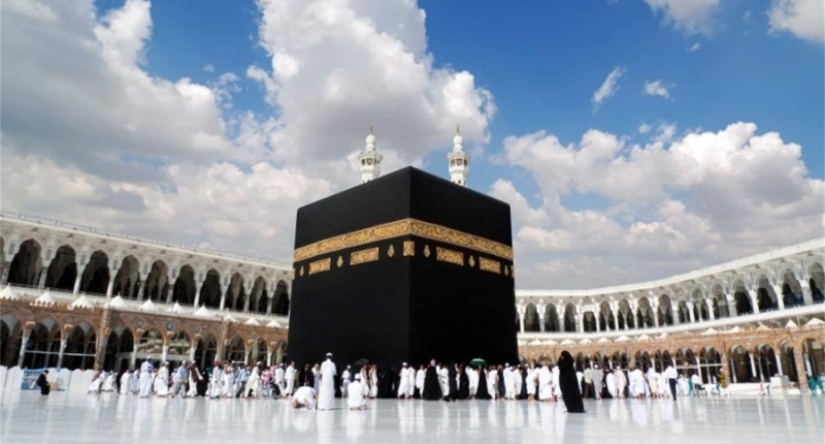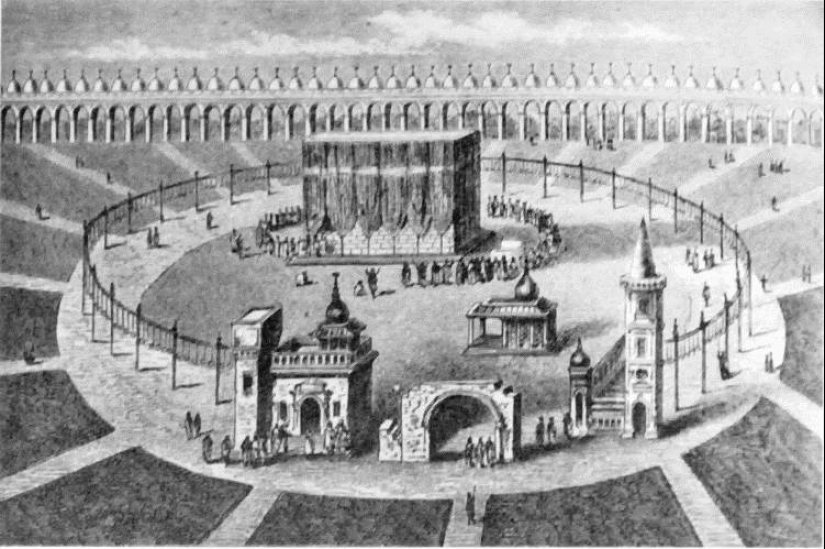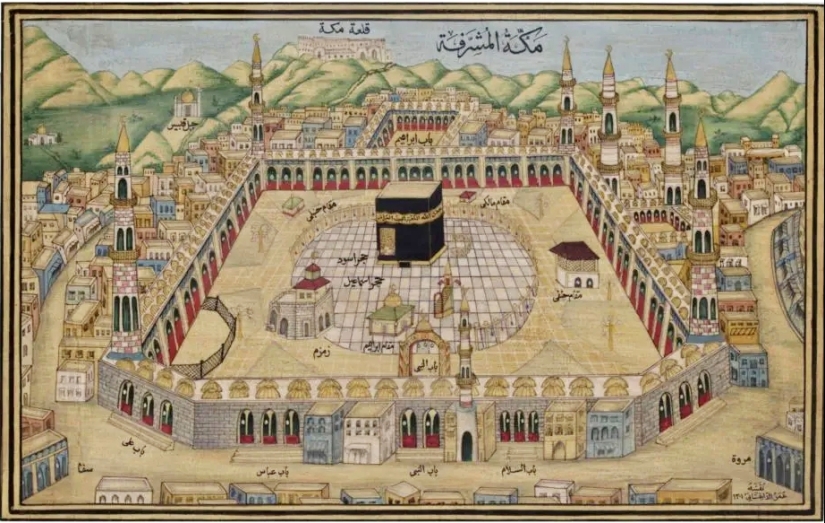What's inside the Kaaba, the Muslim holy site
The most sacred place for all Muslims in the world is the Kaaba. It is a cubic structure located in the courtyard of the Masjid al-Haram in Mecca, Saudi Arabia. Every Muslim strives to perform the Hajj, a pilgrimage to the Kaaba, at least once in their life. It is common to see thousands of believers performing the tawaf, a ritual circumambulation of the shrine, especially during holidays. The golden doors leading to Al-Bayt al-Haram, or the “Sacred House,” as this religious building is sometimes called, also attract attention. But what is inside the shrine?

Many Muslims believe that the Kaaba contains the ashes of Adam, the first man and the forefather of mankind. Some believe that a sacred stone levitates inside the shrine. There are other, even more mysterious versions that cause deep awe among believers. It is worth saying that the faithful have no particular desire to get behind the golden doors. It is quite enough for them to make the traditional walk around the shrine and pray next to it.

The Kaaba is the oldest building in Mecca, considered the "house of Allah". According to legend, it was first built by angels, then by Adam and his son Shis (Sif). Later, the construction was started by the prophets Ibrahim (Abraham) and Ismail. Subsequently, the Kaaba was rebuilt by craftsmen from the Quraysh tribe, which is still considered its custodian, as well as by the companion of the Prophet Muhammad, Ibn az-Zubayr.

The first Kaaba was built in ancient times, long before the advent of Islam. This sanctuary became the main one for the Quraysh tribe, inside which was a statue of their supreme deity - the Man with the Golden Hand, the lord of thunder and lightning. Over time, the building passed into the possession of followers of other religions who lived on these lands or conquered them in wars.
The uncertainty ended when Mecca was liberated by Muslims. The Prophet Muhammad himself entered the Kaaba and personally threw out all the idols inside. Then he destroyed the statues located outside the building with a sabre, among which were figures of ancient gods, as well as Abraham, Jesus and Mary.
The Prophet showed respect only to the Black Stone, embedded in one of the corners of the Kaaba. By touching it with his cane, Muhammad made it an object of special veneration. According to legend, this stone ended up in the wall of the building when Adam was working on it. The forefather of people was looking for unusual minerals and discovered this stone, which many consider to be a meteorite.
They say that initially it was a white sapphire thrown by Allah from Paradise. But over time, the stone became so saturated with human sins that it turned black. Now it is located in the eastern part of the Kaaba and is enclosed in a silver frame. The shrine itself is built on a marble foundation made of dark gray granite blocks quarried near Mecca.
The Kaaba looks black because it is completely covered with a black silk blanket with gold embroidery, the kiswa. It is changed once a year. This important task is entrusted to representatives of the Quraysh tribe: women weave the blanket and decorate it with patterns and sacred texts. Previously, all the work was done by hand, but now a special textile factory, the Kaaba Kiswa, operates in Mecca.
Once upon a time, the kiswah was not black, but white. It was not replaced, but simply laid over the old cloth. This was done during the life of Muhammad and for some time after him - twice a year, before Ramadan and before the Hajj. Later, the color was changed to a less easily soiled black. The use of layers of kiswah ceased after the guardians of the Kaaba turned to the Abbasid Caliph Al-Makhti.
The enormous amount of fabric placed a heavy load on the ancient structure, and there were serious concerns that it might collapse. So they decided to replace the kiswahs, and the removed coverings were cut into pieces, framed with embroidery, and distributed as relics. The covering consists of three parts: the sitar (door curtain), the hizam (Kaaba belt), and the inner green trim.
The door of the Kaaba is truly golden - it is made of 999-carat metal and weighs 280 kg. It was given to the fourth king of Saudi Arabia, Khalid ibn Abdul Aziz. Before that, many different doors were replaced in the shrine. In front of the golden one there was a door made of yew, and the lock from it was transferred to the new door. The keys to this lock have always been kept in the Bani Shaiba family, starting from the time of the Prophet Muhammad. And they still have them to this day.
It is easy to notice that the door is located much higher than the ground level - directly in the wall, without a porch. It was placed at a height of 2.5 meters to prevent the Kaaba from being flooded during floods. Although such cases are extremely rare, they still sometimes happen even in this desert area, where there is little precipitation. Access to the door is provided by a ladder.
Over the millennia of its existence, the Kaaba has experienced many events. It was set on fire, shot at with a catapult, and in 930, the Qarmatians – Islamic schismatic thieves from Bahrain – tore the Black Stone out of the wall and took it with them. To do this, they had to kill a significant part of the inhabitants of Mecca. But after some time, the stone was returned to its rightful place.
What is hidden behind the golden doors? Inside the Kaaba is a small room with three jasper columns supporting the roof. The lower part of the walls is lined with white marble, and the upper part is covered with green silk, which is considered part of the kiswah. Verses from the Koran are embroidered on the fabric.
One corner of the room is left unfinished. This is Rukn al-Yamani, a part of the Kaaba made of unprocessed mountain stone. It is believed that this element of the sanctuary has been preserved from one of the first buildings erected by the prophets Ibrahim (Abraham) and Ismail. There are also several dozen ancient lamps inside, donated to the Kaaba by rulers of different eras.
Once upon a time, the walls inside were decorated with frescoes depicting the Virgin Mary, Jesus Christ, and Abraham. The Prophet Muhammad left them alone, but later someone decided to remove them. Today, nothing inside reminds us of either the pagan or Christian past of this sacred place for Muslims.
The golden door is opened only twice a year. The men of the Bani Shaiba family place a ladder against it and ceremoniously unlock the lock with the keys that the Prophet Muhammad himself once gave to their ancestors. After this, the floor and walls of the room are washed with water from the sacred Zamzam spring, adding incense to it.
The green covers are removed and replaced with new ones. Once a year, family members also remove the kiswa to put on a new cover. Modern technology is used for this — the work is done from a ladder truck. The men do this year after year, so they act quickly and in a coordinated manner. The entire process takes them no more than two hours.
Apart from the guardians of the Kaaba, only a select few are allowed to enter. This includes the king of the country and his family, the governor of Mecca, and high-ranking guests. Of course, all those who are allowed inside the sacred building are followers of Islam.
The Kaaba holds many mysteries and symbols that evoke awe and admiration in believers. Its history, shrouded in myths and traditions, remains an unchanging reminder of the importance of spiritual connection. What do you think about the role of such sacred places in the modern world? Perhaps you have stories or thoughts related to visiting religious shrines? Share your opinion in the comments!
